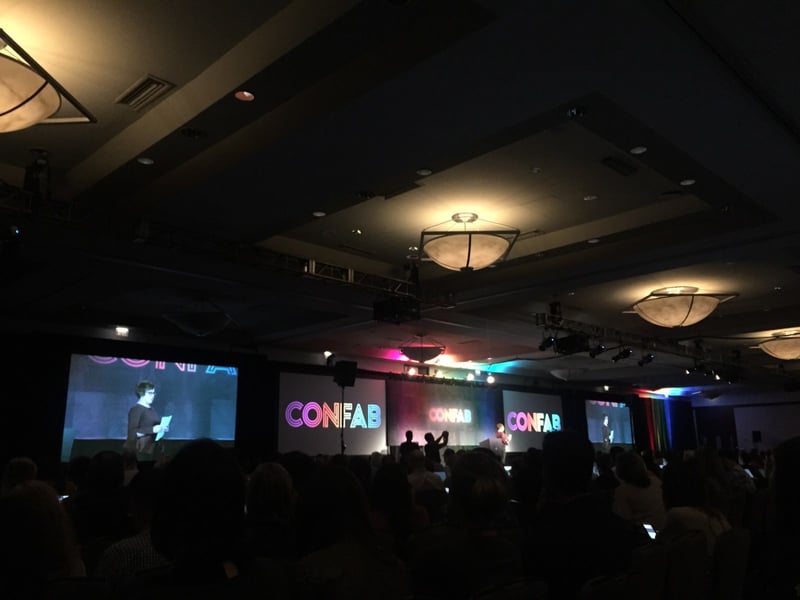 It’s been two weeks since Confab 2018 wrapped, but being back in the daily grind makes it seem like months ago.
It’s been two weeks since Confab 2018 wrapped, but being back in the daily grind makes it seem like months ago.
The content strategy conference (my first) was full of informative sessions, awesome people and all the #confabfeelings that I don’t want to forget. So I decided to capture my favorites.
Here are my top takeaways that I hope to remember and carry out this year:
It’s good to be around “your people.”
According to the event’s website, Confab is an event for people who design, create, and manage content. From UX to storytelling, accessibility to structure, Confab brings together those who are committed to making content useful and usable.
They invite you to “Come find your people at Confab.” And man, it was good to be around my people.
To be in a room full of people who know what you do, understand the joys and struggles of the job, and to not have to explain that no, I’m not just a copywriter, was a joy.
Content strategy is earning its rightful reputation.
It was encouraging to see how far-reaching content strategy is and where it’s being adopted. From federal banks and government institutions to nonprofits and start-ups, the practice is becoming a priority across a variety of industries (yay!).
You can help build and support your content strategy team by telling your story.
One of the best ways to make content strategy important in your industry is to tell people about it, according to Marissa Phillips, Head of Content Strategy at Airbnb.
The more you can educate your company and co-workers on what you do and why it’s important, the more content strategy becomes viewed as valuable.
Tell your story, educate your partners and stay top-of-mind.
Building and supporting your content strategy team
Marissa Phillips, Airbnb
Sharing is truly a form of caring.
It’s important to participate in the content strategy meetups and online groups because by sharing about content strategy and helping each other, we’re actually building the brand of content strategy.
#Confabfeelings
Saskia Videler, Efficiently Effective podcast / The Dutchess
Listening can be your greatest tool.
Whether you’re interviewing internal stakeholders or your target audience members, give them the space and time to articulate their priorities, their goals, and their needs by actively listening.
Being an active listener means you don’t assume you know the answers. You allow others to fill in the silence. You listen, absorb, then respond.
Telling strategic stories
Brittney Dunkins, Senior Associate and Content Editor at JPMorgan Chase
Your audience doesn’t need a shovel, they need a hole.
Scott Kubie, Lead Content Strategist at Brain Traffic, made this humbling point: No one needs your website, no one needs web pages (you can’t eat them, you can’t find shelter in them).
Focusing on exactly what a user is looking for during each step of their journey (specifically, when they come to your digital properties) will help you create content that’s truly valuable.
User-centered content strategy: Journeys, stories, maps, and more
Scott Kubie, Brain Traffic
Style guides are an opportunity for inclusivity.
Creating your company’s style guide gives you the chance to understand what organizational challenges exist and what barriers your content currently puts in the way of users, according to Mai-Ling Garcia, Digital Engagement Officer for the City of Oakland.
For example, are you making your content too difficult to read? Is it written for the right reading level? In the right language?
Once you tap into these issues, you can start to create a guide that infuses inclusive language and design into everyday life.
Speaking truth to power: How to build equity through writing and design standards
Mai-Ling Garcia, City of Oakland
User testing can be easy and affordable.
You can even run a lab test on a budget. All you need is two days (one for planning, one for testing), a way to reward testers (Ida Aalen of Confrere found Cinnabons to be very effective), and a laptop with screen recording capabilities.
Invite people through social media, or go out to where you think your users might be (e.g., a train station). Recruit, test, then document what you find.
Easy and affordable user testing
Ida Aalen, Confrere
SEO should be inspired by people (not algorithms).
Chris Corak of ONWARD posed this thought-provoking question: Google is just trying to give people what they want, so why wouldn’t we cater our strategy to people instead of algorithms?
Empathy behind the algorithms: Creating people-driven SEO
Chris Corak, ONWARD
Write better copy by getting in touch with your human side.
When writing UX copy, you’ve got to choose to be radically human, according to Andrew Schmidt of Slack. Not overly casual, but just trying to sound the way people sound when they talk about what you’re writing about.
This is a personal struggle for me – my first drafts typically ready like they were written by a robot. By keeping your user/audience and the way they speak top of mind, you’ll be able to create copy that makes a connection.
Writing for buttons (and everything else): How UX teams can craft stronger copy
Andrew Schmidt, Slack
Empathy is essential in all situations. Especially in error messages.
The classic “Oops” or “Uh-oh, something’s wrong” message can be confusing and even make a user feel like it’s their fault when something goes wrong. (Full disclosure: I’m guilty of using the “Oops” messaging.)
Empathetic error messages don’t assign blame, they provide a small amount of info that lets a user know what led to the error and what to do next. Getting there requires you to plan for when something goes wrong so you can create a message that’s aligned with your brand.
Oops! Don’t Do It Again: Why Empathy Is Essential in Error Messages
Alexa Apallas, Senior Content Designer, Customer Experiences at PayPal
Zombies can help you communicate better with your audience.
Plain language is communication that your audience can find and understand the first time they hear or read it. Passive voice is a no-no in the world of plain language.
Katherine Spivey, the Co-Chair of PLAIN, provided this unforgettable rule: if you can add “by zombies” at the end of a sentence, it’s passive.
Here’s an example:
- Mistakes were made by zombies. (passive)
- Zombies made mistakes. (active)
Plain Language Without Tears
Katherine Spivey, Co-Chair of PLAIN
Introverts rock. Just sometimes quietly.
As an introvert, it can be difficult to constantly be called on to share your ideas and thoughts. Alison Hall, writer and editor for the U.S. Copyright Office at the Library of Congress, had great advice that rang true for this introvert: focus on what you’re good at, whether it’s including people, relating to people, or learning, then lean into those to create opportunities to show your strengths.
The Introvert’s Guide to Content Strategy Success
Alison Hall, Writer/Editor, U.S. Copyright Office at the Library of Congress
Pair writing can help strengthen your strategy.
Pair writing is the practice of a content creator sitting down with a subject matter expert to collaborate on copy. It allows copy to become a part of design and turns non-writers into writers who are champions of writing.
Two heads are better: the benefits of pair writing
Julie Threlkeld, Principal Content Strategist, Client and User Experience, Pitney Bowes
Presenting something important? Make sure you have the right people in the room.
Specifically stakeholders. Dayana Kibilds of Western University recommends this list:
- Your biggest advocates. These are the people that will almost always say yes to your ideas.
- Your most adamant naysayers. This is the person or people who will almost always say no.
- Reasonable, respected decision makers. Make sure you have a neutral party who will go back and forth between the positives and negatives of an idea to help come to a conclusion. These people will help sway the naysayers and give the advocates more depth in their perspective.
The art and science of collaboration
Dayana Kibilds, Western University
Always celebrate the wins.
Vanessa Roman of Rutgers School of Nursing made this excellent point in her session: We work so hard to create great content experiences for our users, but often forget to make the process enjoyable for ourselves.
Injecting delight into the content creation experience is as important as injecting delight into the user experience.
How to eat an elephant: Tackling your content giants
Vanessa Roman, Rutgers School of Nursing
Superficial diversity will disengage those who you want to engage.
If your brand is trying to engage those in the margins – people who have experienced discrimination and isolation because of their identity – it must go beyond the superficial. That means the diversity you want to project must be represented in your brand and company.
Marchaé Grair, Director of PR and Outreach at the Unitarian Universalist Association, said it best: “Nothing about us without us. If you don’t have marginalized people creating content, making content decisions, then you can’t create content for them.”
Centering the Margins in Outreach
Marchaé Grair, Director of PR and Outreach, Unitarian Universalist Association
Tech will only become inclusive if its creators decide to make it that way.
It seems obvious, but author and strategist Sara Wachter-Boettcher gave a few shocking examples from big tech companies that have built biases into their tech.
The worst was Facebook’s “Year in Review” feature that showed a man’s most liked photo of the previous year: his daughter, who died from cancer that year. It was surrounded by dancing cartoon figures and confetti.
Sara made the case for how important it is to make inclusive design an explicit part of projects, so every step of the way you ask:
- How might this hurt somebody?
- Who might this leave out?
- Who could this go wrong for?
- Do we have scenarios aimed at the best-case scenario, and the user who’s in a stressful situation?
She left us with this rousing call to action: “Something that unites us as content strategists, it’s not just our love of spreadsheets or our stance on commas. What we need to be able to do as we’re gaining influence is, we really need to decide how we’re going to use the influence that we have.”
Our mission is to create tech that’s humane, content that’s compassionate, and work that builds equality.
Inclusive content, ethical tech, and you
Sara Wachter-Boettcher, Author and strategist




